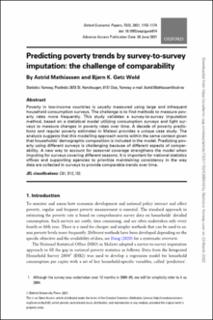| dc.contributor.author | Mathiassen, Astrid | |
| dc.contributor.author | Wold, Bjørn K. Getz | |
| dc.date.accessioned | 2022-03-24T17:46:38Z | |
| dc.date.available | 2022-03-24T17:46:38Z | |
| dc.date.created | 2021-10-05T19:27:06Z | |
| dc.date.issued | 2021 | |
| dc.identifier.citation | Oxford Economic Papers. 2021, 73 (3), 1153-1174. | en_US |
| dc.identifier.issn | 0030-7653 | |
| dc.identifier.uri | https://hdl.handle.net/11250/2987486 | |
| dc.description.abstract | Poverty in low-income countries is usually measured using large and infrequent household consumption surveys. The challenge is to find methods to measure poverty rates more frequently. This study validates a survey-to-survey imputation method, based on a statistical model utilizing consumption surveys and light surveys to measure changes in poverty rates over time. A decade of poverty predictions and regular poverty estimates in Malawi provides a unique case study. The analysis suggests that this modelling approach works within the same context given that households’ demographic composition is included in the model. Predicting poverty using different surveys is challenging because of different aspects of comparability. A new way to account for seasonal coverage strengthens the model when imputing for surveys covering different seasons. It is important for national statistics offices and supporting agencies to prioritize maintaining consistency in the way data are collected in surveys to provide comparable trends over time. | en_US |
| dc.language.iso | eng | en_US |
| dc.publisher | Oxford University Press | en_US |
| dc.rights | Navngivelse-Ikkekommersiell-DelPåSammeVilkår 4.0 Internasjonal | * |
| dc.rights.uri | http://creativecommons.org/licenses/by-nc-sa/4.0/deed.no | * |
| dc.title | Predicting poverty trends by survey-to-survey imputation: The challenge of comparability | en_US |
| dc.type | Peer reviewed | en_US |
| dc.type | Journal article | en_US |
| dc.description.version | publishedVersion | en_US |
| dc.rights.holder | This is an Open Access article distributed under the terms of the Creative Commons Attribution License (http://creativecommons. org/licenses/by/4.0/), which permits unrestricted reuse, distribution, and reproduction in any medium, provided the original work is properly cited. | en_US |
| dc.subject.nsi | VDP::Samfunnsvitenskap: 200::Økonomi: 210 | en_US |
| dc.source.pagenumber | 1153-1174 | en_US |
| dc.source.volume | 73 | en_US |
| dc.source.journal | Oxford Economic Papers | en_US |
| dc.source.issue | 3 | en_US |
| dc.identifier.doi | 10.1093/oep/gpab014 | |
| dc.identifier.cristin | 1943567 | |
| cristin.ispublished | true | |
| cristin.fulltext | original | |
| cristin.qualitycode | 1 | |

